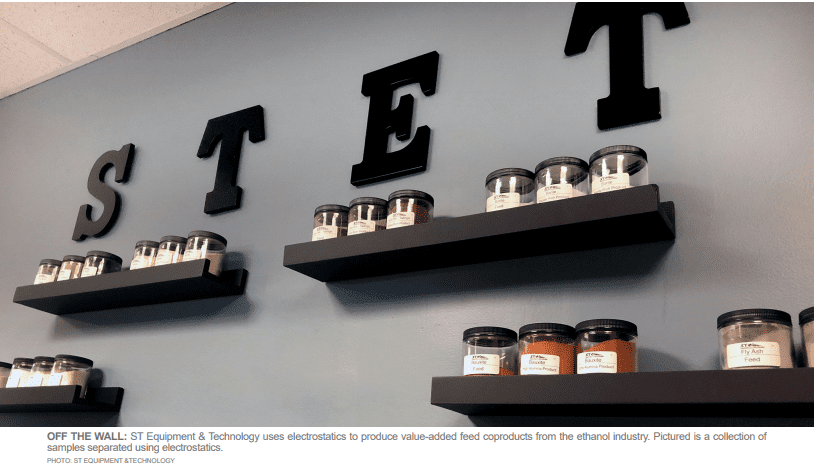Khetha ulimi:
 Njengoba amamajini emikhiqizweni ye-ethanol aqina noma anyamalale, abakhiqizi abaningi be-ethanol bakhetha ukugxila ekudalweni kwenani kusuka kumakhemikhali. Izinhlamvu ezomisiwe ze-distillers ezinama-solubles (DDGS) have long been an undervalued coproduct. Kepha ku- 28 ukuze 32 amaphesenti amaprotheni, iqukethe amaprotheni amaningi kakhulu ukubona inani lawo eliphelele njengokuphaka okukhanyayo, kuyilapho ngasikhathi sinye iphansi kakhulu kumaprotheni ukuze isetshenziswe kwizilinganiso eziphakeme kakhulu zokuphakelwa kokudla okufana nokufuya, swine, and poultry.
Njengoba amamajini emikhiqizweni ye-ethanol aqina noma anyamalale, abakhiqizi abaningi be-ethanol bakhetha ukugxila ekudalweni kwenani kusuka kumakhemikhali. Izinhlamvu ezomisiwe ze-distillers ezinama-solubles (DDGS) have long been an undervalued coproduct. Kepha ku- 28 ukuze 32 amaphesenti amaprotheni, iqukethe amaprotheni amaningi kakhulu ukubona inani lawo eliphelele njengokuphaka okukhanyayo, kuyilapho ngasikhathi sinye iphansi kakhulu kumaprotheni ukuze isetshenziswe kwizilinganiso eziphakeme kakhulu zokuphakelwa kokudla okufana nokufuya, swine, and poultry.
This is a common challenge across the animal feed industry and represents a huge opportunity in the field of precision animal nutrition, kuchazwa njengokuhlinzeka ngesilwane okuphakelayo okuhlangabezana kahle nezidingo zaso zokudla. Amanye amathuba, such as the rapid growth of aquaculture and the high cost and limited availability of fish meals, qinisa lo mkhuba wemakethe.
Yomile, Wet, and Electrostatics Okusanda, multiple technologies have entered the market to address the need to generate high-protein coproducts. These technologies can be classified into two segments: lezo ezihlanganiswe nenqubo yokukhiqiza i-ethanol futhi zisebenza emifudlaneni yenqubo emanzi. And those that occur after the ethanol production process and operate on dry process streams. The wet technologies often utilize combination of separation methods that rely on particle size modification such as grinding, ukuhlukaniswa kosayizi wezinhlayiyana njengokuhlunga noma ukuhlolwa, nokwahlukana kwabantu abaningi njengokuhlukaniswa kwesiphepho ukwehlukanisa imvubelo ku-fiber yezitshalo. These systems may be before or after the fermentation stage. Nokho, the separation of protein from fiber occurs before distillers grains are dried. These wet systems are integrated into ethanol process and therefore operate simultaneously with ethanol plant.
Ngokuphambene, dry processing methods are independent of the ethanol production process futhi esikhundleni salokho usebenze ekusakazweni kwe-DDGS ngqo. Izinhlelo ezinjalo zivame ukusebenzisa ukugaya, air classification, or dry sieving. Enye indlela yenoveli isebenzisa ukwahlukaniswa kwe-electrostatic ukukhiqiza amaprotheni aphezulu i-DDGS ngokususa i-fiber endaweni engenamanzi ngokuphelele, inqubo yokubuyela emuva ezimele kunqubo yokukhiqiza i-ethanol.
I-Electrostatics yinto cishe wonke umuntu azibonele yona empilweni yansuku zonke, kodwa bambalwa abahlangane nabo esimweni sezimboni. It is the effect of rubbing a balloon on a person’s hair. Njengoba ibhaluni lenjoloba lihlangana nezinwele zomuntu, isusa ama-electron ezinweleni. Lokhu kungenxa yokuthi injoloba kanye nama-polymers amaningi ane-electronegativity ephezulu (ukusondelana kwama-electron). Ibhaluni lisele nenetha elingelona elifanele, sengithole ama-electron angeziwe, nezinwele zesifundo zinecala elihle. Electrical charges repel each other, ngakho-ke izinwele zezihloko ziyasukuma ekugcineni ngomzamo wokukhulisa ibanga phakathi kwemicu yezinwele ekhokhiswa kahle.
Endabeni ye-DDGS, protein and fiber acquire opposite electrical charges upon contact with each other, allowing them to be separated from each other in a high-strength electric field.
Electrostatics is not a new phenomenon and has a large number of real-world and industrial applications. Ukuhlukaniswa kwe-electrostatic has been used by selected industries for many years. In mineral processing and recycling applications, ngokwahlukana electrostatic ubelokhu ukusetshenziswa kwezohwebo okungenani 50 iminyaka. Ukwehlukaniswa kwe-electrostatic kwezinto ezisuselwa ezitshalweni kuphenywe isikhathi esingaphezulu 140 iminyaka, ne-patent yokuqala yokwehlukaniswa kwe-electrostatic kafulawa wamabele ophakathi okwafakwa ngaphambi kwesikhathi 1880.
Okusanda, ukucutshungulwa kwe-electrostatic kuthole ukunakwa okukhulu njengendlela yokugxilisa amaprotheni ezitshalo. Lesi senzakalo iye yashesha esikhathini esidlule 10 ukuze 20 iminyaka, ngamanyuvesi amaningi ocwaningo eYurophu nase-U.S. ukusebenzisa amasu wokwehlukaniswa kwe-electrostatic ezinhlotsheni ezahlukahlukene kubandakanya iDDGS, ukudla oilseed, ne-pea kanye ne-pulse protein. Kule ucwaningo, kusobala ukuthi izindlela electrostatic ezingadala ukukhiqiza entsha, izithako zemikhiqizo yamaprotheni anenani eliphakeme, futhi unikele ngenye indlela yezindlela zokucubungula ezimanzi.
Izindlela zokuhlukaniswa kwe-electrostatic zinikeza izinzuzo ngaphezu kwezindlela zokuhlukanisa ezimanzi, kufaka phakathi izindleko nokusebenza okuvela kwinqubo yokukhiqiza i-ethanol. Izindlela zokuhlukanisa i-Electrostatic nazo zinikeza inzuzo yokungadingi amakhemikhali noma amanzi. That makes cleaning easier since the rate of bacterial growth is reduced in dry products. Futhi ukwahlukana kwe-electrostatic kumnene, ngoba ayishintshi ukusebenza kweprotheni lendabuko.
ST Izinsiza kusebenza & Ubuchwepheshe besilokhu sisebenzisa ukwahlukana electrostatic e izicelo zezimboni kusukela 1995. It is used to process fly ash from coal power plants. Ngokuhamba 20 amathani ayisigidi womkhiqizo impukane umlotha kusetshenzwe yi-STET separators efakwe e-U.S. yedwa.
Yize kwabanye, repurposing technology to process fly ash (i-aluminosilicate mineral enengilazi eshiye ekushiseni amalahle amandla) ukugxilisa amaprotheni ezitshalo avela ku-DDGS kungabonakala kungajwayelekile. In truth, imakethe ye-DDGS kanye nemakethe yomlotha we-fly share babelana ngokufana okumangazayo. Okokuqala, both products are generated in large volumes in the U.S. With an estimated 36 million metric tons of distillers grains produced by the U.S. umkhakha we-ethanol ku 2019. Ngokuqhathanisa, iU.S. imboni yamandla amalahle yakhiqizwa nxazonke 35 amathani ayizigidi eziyizinkulungwane zemfucumfucu yomlotha ngaphakathi 2017. Yomibili le mikhiqizo ithengiswa emaphethelweni aphansi. Their value is highly dependent on processing and transporting large volumes at low costs.
Both DDGS and fly ash ultimately derive their value from displacing other higher-cost materials. Fly esikhundleni sikasimende, the most expensive component in ready-mix concrete. I-DDGS incintisana neminye imithombo yamaprotheni efana nesoya, canola, and sunflower meal, phakathi kwabanye.
DDGS and fly ash have to make the journey from low-value waste stream to value-added coproduct. Fly ash was long considered a waste product. To be landfilled until low-cost technologies enabled it to be recycled as a value-added component in ready-mix concrete. I-DDGS yenze ukuziphendukela kwemvelo okufanayo, from being considered a low-value feed material to becoming a manufactured feed ingredient. It is globally exported and increasingly sold under trademarked names with an emphasis on quality and consistency.
Ekugcineni, it looks likely that the long-term trend of maximizing the value of ethanol coproducts, kufaka phakathi izinhlamvu ze-distillers, izoqhubeka. Ukucubungula ubuchwepheshe kuzoqhubeka kubaluleke kakhulu ekukhuliseni ukusebenza kobuchwepheshe kwamaprotheni ekhiqizwa. Futhi, shaping their value-creation potential for the ethanol industry.
Lobu buchwepheshe buzodinga ukukhombisa ukusebenza okungaguquguquki, ukuthembeka okuphezulu, low cost, and rapid return of capital to end users. Xhumana nathi now for more information.